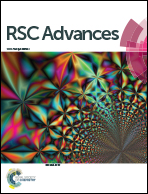Nitrogen and sulfur co-doped graphene aerogels as an efficient metal-free catalyst for oxygen reduction reaction in an alkaline solution
Abstract
Nitrogen and sulfur dual-doped three dimensional (3D) graphene aerogels (N–S-GAs) are firstly prepared through pyrolyzing poly[5-amino-1,3,4-thiadiazole-2-thiol] coated graphene aerogels (PATT-GAs) as a metal-free oxygen reduction reaction (ORR) catalyst. 3D structures of N–S-GAs have been reserved after high temperature pyrolyzing, and N and S atoms are successfully doped into graphene frameworks. The catalytic performance of the fabricated N–S-GAs towards the ORR is assessed by electrochemical test techniques. The effects of pyrolyzing temperature on catalytic activity are also studied. The binding states of N and S atoms have a great influence on the electrocatalytic activity for the ORR. The N–S-GAs gained after pyrolysis at 900 °C (N–S-GAs 900) demonstrate higher electrocatalytic activity and diffusion-limiting current density, better stability and methanol tolerance. The excellent performance for the ORR on N–S-GAs is attributed to the interconnected porous network, conductive multiplexed pathways of N–S-GAs, greater electrocatalytically active site exposure and the synergistic effect originating from the doped N and S in the graphene sheets.


 Please wait while we load your content...
Please wait while we load your content...